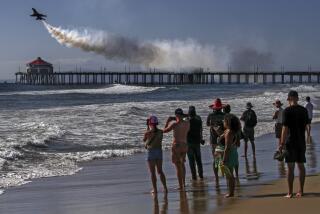Once High-Flying Air/Space America Takes Last Bankruptcy Nosedive : Aerospace: Collapse that began with canceled 1990 Otay Mesa air show ends with assets of $25,000 to pay $2 million of claims.
- Share via
It’s been a year since Air/Space America, once hailed by its organizers as the nation’s answer to the fabled Paris Air Show, collapsed while preparing for its second show at Brown Field on Otay Mesa.
Air/Space America, which crash-landed in a sea of red ink in April, 1990, has spent the past year in U.S. Bankruptcy Court, where nearly 100 creditors have filed claims totaling $2 million. Less than a third of Air/Space America’s 300 original creditors even bothered to file claims against the trouble-plagued show.
The organization will have only $25,000 to distribute among creditors when bankruptcy proceedings end later this year, said Ralph Boldt, Air/Space America’s court-appointed trustee.
“I’m not going to be getting anything back, I know that,” said Richard Quick, owner of El Cajon-based Shadetree Airmotive, a flight operations firm that is one of the air show’s largest creditors. “At least I can write it off,” said Quick of Shadetree’s $143,857 claim.
Air/Space America’s inglorious end was in stark contrast to the longstanding dream of former U.S. Rep. Robert Wilson, 75, who in 1986 unveiled a grand plan to establish an international trade exposition and public air show that would be held at Brown Field during the spring in even-numbered years.
During a 1986 press conference, Wilson predicted that the event eventually would provide 1,000 jobs, generate a $28-million payroll and pump $117 million into the local economy during show years.
Instead, the 1988 show generated a $2.8-million debt that Air/Space America never overcame when it came time to raise funds for the second show in 1990.
Just weeks before the May, 1990 show was scheduled to begin, vendors publicly complained that they weren’t being paid. Exhibitors from as far away as the Soviet Union and China complained that their telephone calls and telegrams weren’t being answered by organizers.
Show promoters steadfastly maintained that the show would go on. But, on April 18, Wilson canceled the show, and, on July 2, 1990, Air/Space America tumbled into bankruptcy.
Air/Space America will cease to exist later this year, shortly after Boldt disposes of the organization’s sole remaining asset--a nonfunctioning experimental airplane that will be donated to a group of airplane aficionados.
Wilson still blames City Hall for the show’s failure.
“The lack of support from the City of San Diego was the major reason we couldn’t (draw financial support) for the second show,” Wilson said. “It’s a shame we didn’t get the support we needed.”
But some Air/Space America suppliers and organizers believe that the show’s troubles were driven by an overly ambitious plan that exceeded the show’s ability to attract funding.
“The real problem at Air/Space America was the way that they jumped in with both feet,” said Chuck Hoover, president of an Arizona-based company that was hired to help direct aerial performances at the two-week show in 1990. “God bless them for their ballsy way of doing business, but, financially, it didn’t make it.”
“There are ways to raise money and ways not to raise money,” said Quick, who stopped working on the second show when it became apparent that he would not be paid for the 1988 show. “Unfortunately, some of the people (Air/Space America) chose were not as adept as they should have been.”
Quick tied Air/Space America’s financial woes to a 1988 ticket snafu that resulted in thousands of non-paying customers being admitted to the weekend air shows. Although attendance hit about 400,000, “only something like 25,000 of them were paid, and we needed 300,000 to break even,” Quick said.
William Walsh, a retired U.S. Navy admiral who served as president of Air/Space America from July, 1986 to June, 1989, blamed the air show’s failure on its inability to draw funding from major aerospace companies such as Boeing, Lockheed, McDonnell Douglas, Pratt & Whitney and General Electric.
Although Walsh described the initial show in 1988 as “a good time, a hell of a good show,” Air/Space America’s inability to attract major aerospace companies meant that the organization “couldn’t get (financing) from anybody.”
Walsh, who is seeking nearly $140,000 in back wages from the bankrupt organization, described Air/Space America as “a carefully constructed deck of cards” that fell apart as the second show approached. As is the case with other creditors, Walsh has no real expectation of recovering his claim.
Hundreds of smaller companies exhibited at the 1988 trade show at Brown Field, but “I don’t believe the aerospace industry in America wanted it,” Walsh said. He said it never backed Air/Space America like it did the Paris Air Show or England’s Farnborough Air Show.
“We were flat told by the industry that they didn’t want” an American air show, Quick said. “They said that they’d go to Paris and Farnborough, and that was enough.”
Wilson maintained that the major aerospace companies boycotted Air/Space America because they didn’t want “companies from Europe coming here . . . (to) the biggest aerospace market in the world.”
Wilson, who took out a second mortgage on his San Diego home to help pay air show bills, said he lost $60,000 on Air/Space America. “I felt it was a worthwhile thing to do,” Wilson said. “It was something I hoped to be proud of.”
More to Read
Inside the business of entertainment
The Wide Shot brings you news, analysis and insights on everything from streaming wars to production — and what it all means for the future.
You may occasionally receive promotional content from the Los Angeles Times.










